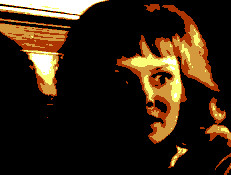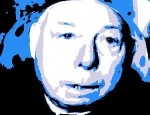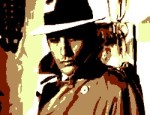Film Review

Nightmare has the same spooky atmospherics and teasing sense of anticipation that pervades Paranoiac but in addition it has a sustained visual drama, more dreamlike than realistic, that gives it a far greater sense of menace. Remarkably, it manages to pull off the Les Diaboloques 'denouement twist' twice, taking the spectator completely by surprise on both occasions, with the second half of the film mischievously mirroring (or seeming to mirror) the first half. Repetition can be a dangerous gimmick but here it is used to masterful effect, not just in the plot, but also in the repeated visuals (notably the long tacking shots through a shadowy mausoleum, borrowed no doubt from Alain Resnain's Last Year in Marienbad (1961)), which help to create the illusion of a recurring nightmare in which the spectator is as trapped as the helpless protagonists. The film's opening sequence is arguably the most haunting of any Hammer horror film, and fixes in the mind of the audience a thematic motif that recurs throughout the film - a sense of unavoidable entrapment from which death or insanity are the only release.
After his stunning work on Paranoiac (1963), his first film for Hammer, Freddie Francis was eminently well suited to direct Nightmare, and, assisted by cinematographer John Wilcox, he brings to Sangster's labyrinthine plot a suitably maze-like sense of claustrophobia. Francis also directed Hammer's Gothic piece The Evil of Frankenstein (1964) and several horror anthology films for rival company Amicus, including Dr. Terror's House of Horrors (1965), but these appear prosaic when compared with the far more chilling and darkly poetic Nightmare, which probably rates as Francis's best film as a director. Certainly, the spectacle of two seemingly ordinary young women being driven to insanity has a frightening reality that no quantity of gore and cheap supernatural thrills can match.
Making her film debut (as a last minute replacement for Julie Christie), Jennie Linden keeps her performance on the right side of hysteria as her character, Janet, falls foul of a diabolical plot conceived by her supposedly loving guarding David Knight and his mistress Moira Redmond (the latter's resemblance to Simone Signoret in both Les Diaboliques and Marcel Carné's Thérèse Raquin is an eerie coincidence). What pushes Janet over the edge is a ghostly apparition in white played by Clytie Jessop, best known for her role as the sinister Miss Jessel in Jack Clayton's The Innocents (1961), on which Freddie Francis happened to be the cinematographer.
Brenda Bruce has a scary presence at the start of the film and immediately we can sense that she has a far greater role in the proceedings than her first appearance might suggest. Even the supposedly benign housekeeper, Irene Richmond, and chauffeur, George A. Cooper, have an aura of mischief about them. No one in this film is quite what he seems, and that is what makes it such fun. Surprise lurks around every corner, the biggest surprise naturally being reserved for the very last scene when all is finally revealed. Nightmare lives up to its title, a taut little shocker that grabs you by the throat and doesn't let go until the closing credits start rolling across the screen. Dreams are made of this...
© James Travers 2015
The above content is owned by frenchfilms.org and must not be copied.
Film Synopsis
17-year-old Janet is attending a boarding school when she begins suffering a series of nightmares in which she ends up imprisoned in a padded cell with her mother. Six years previously, Janet's mother was placed in an asylum for the insane after stabbing her husband to death on Janet's birthday. The girl is sent home from school to recover from her mental disturbance, watched over by her devoted guardian, Henry Baxter. The latter, a busy lawyer, is unable to greet Janet at the grand old house she has inherited from her parents, and so provides her with a companion, Grace. Immediately after her arrival in the house, Janet continues experiencing troubling nightmares, only now these involve an unfamiliar woman with a facial scar. Janet is on the verge of insanity when Baxter turns up and introduces her to his wife, who is the exact image of the woman in her dreams. In a frenzy, Janet stabs the woman to death. It would seem that Baxter and Grace have committed the perfect murder, until Grace begins to suspect that her lover is planning to kill her...© James Travers
The above content is owned by frenchfilms.org and must not be copied.
Similar Films
Here are some other films you may enjoy watching:- Frankenstein and the Monster from Hell (1974)
- Them! (1954)
- To the Devil a Daughter (1976)
- The Creeping Flesh (1973)
- Hands of the Ripper (1971)
Other related links:
Film Credits
- Director: Freddie Francis
- Script: Jimmy Sangster
- Cinematographer: John Wilcox
- Music: Don Banks
- Cast: David Knight (Henry Baxter), Moira Redmond (Grace Maddox), Jennie Linden (Janet), Brenda Bruce (Mary Lewis), George A. Cooper (John), Clytie Jessop (Woman in White), Irene Richmond (Mrs. Gibbs), John Welsh (Doctor), Timothy Bateson (Barman), Elizabeth Dear (Janet as a Child), Isla Cameron (Mother), Julie Samuel (Maid), Hedger Wallace (Sir Dudley)
- Country: UK
- Language: English
- Support: Black and White
- Runtime: 83 min
The greatest French film directors

The very best French thrillers

The best of Russian cinema
